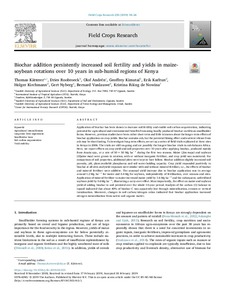| dc.contributor.author | Kätterer, T. |
| dc.contributor.author | Roobroeck, D. |
| dc.contributor.author | Andrén, O. |
| dc.contributor.author | Kimutai, G. |
| dc.contributor.author | Karltun, E. |
| dc.contributor.author | Kirchmann, H. |
| dc.contributor.author | Nyberg, G. |
| dc.contributor.author | Vanlauwe, Bernard |
| dc.contributor.author | Nowina, K.R. de |
| dc.date.accessioned | 2019-12-04T11:33:10Z |
| dc.date.available | 2019-12-04T11:33:10Z |
| dc.date.issued | 2019-04-01 |
| dc.identifier.citation | Kätterer, T., Roobroeck, D., Andrén, O., Kimutai, G., Karltun, E., Kirchmann, H., ... & de Nowina, K.R. (2019). Biochar addition persistently increased soil fertility and yields in maize-soybean rotations over 10 years in sub-humid regions of Kenya. Field Crops Research, 235, 18-26. |
| dc.identifier.issn | 0378-4290 |
| dc.identifier.uri | https://hdl.handle.net/20.500.12478/5530 |
| dc.description | Open Access Article |
| dc.description.abstract | Application of biochar has been shown to increase soil fertility and enable soil carbon sequestration, indicating potential for agricultural and environmental benefits from using locally produced biochar on African smallholder farms. However, previous studies have been rather short-term and little is known about the longer-term effects of biochar application on crop yields. Biochar contains ash, but the potential liming effect and nutrient release from ash may be short-lasting. To investigate long-term effects, we set up a series of field trials replicated at three sites in Kenya in 2006. The trials are still on-going and are possibly the longest biochar trials in sub-Saharan Africa. Here, we report effects on crop yield and soil properties over 10 years after applying biochar, produced mainly from Acacia spp., at a rate of 50 + 50 Mg ha−1 during the first two seasons. Maize (Zea mays) and soybean (Glycine max) were grown in rotation, with or without inorganic fertiliser, and crop yield was monitored. For comparison of soil properties, additional plots were kept in bare fallow. Biochar addition slightly increased soil porosity, pH, plant-available phosphorus and soil water-holding capacity. Crop yield responded positively to biochar at all sites and yield responses were similar with and without mineral fertiliser, i.e., the effects of biochar and mineral fertiliser were additive. The seasonal yield increase due to biochar application was in average around 1.2 Mg ha−1 for maize and 0.4 Mg for soybean, independently of fertilisation, over seasons and sites. Application of mineral fertiliser to maize increased maize yield by 1.6 Mg ha−1 and the subsequent, unfertilized soybean yield by 0.6 Mg ha−1, illustrating a carry-over effect. Most importantly, the effect on maize and soybean yield of adding biochar to soil persisted over the whole 10-year period. Analysis of the carbon (C) balance in topsoil indicated that about 40% of biochar C was apparently lost through mineralization, erosion or vertical translocation. Moreover, changes in soil carbon/nitrogen ratios indicated that biochar application increased nitrogen mineralization from native soil organic matter. |
| dc.description.sponsorship | Swedish Research Council for Environment, Agricultural Science and Spatial Planning |
| dc.format.extent | 18-26 |
| dc.language.iso | en |
| dc.rights | CC-BY-NC-ND-4.0 |
| dc.subject | Agricultural |
| dc.subject | Intensification |
| dc.subject | Soil |
| dc.subject | Carbon |
| dc.subject | Stability |
| dc.subject | Field Experiments |
| dc.subject | Smallholders |
| dc.subject | Farms |
| dc.subject | Yields |
| dc.subject | Soil Fertility |
| dc.title | Biochar addition persistently increased soil fertility and yields in maizesoybean rotations over 10 years in sub-humid regions of Kenya |
| dc.type | Journal Article |
| dc.description.version | Peer Review |
| cg.contributor.crp | Climate Change, Agriculture and Food Security |
| cg.contributor.crp | Maize |
| cg.contributor.affiliation | Swedish University of Agricultural Sciences |
| cg.contributor.affiliation | International Institute of Tropical Agriculture |
| cg.contributor.affiliation | Oandren, Björklundavägen |
| cg.contributor.affiliation | Center for International Forestry Research |
| cg.coverage.region | Africa |
| cg.coverage.region | East Africa |
| cg.coverage.country | Kenya |
| cg.creator.identifier | Dries Roobroeck: 0000-0003-3176-4444 |
| cg.creator.identifier | bernard vanlauwe: 0000-0001-6016-6027 |
| cg.researchtheme | NATURAL RESOURCE MANAGEMENT |
| cg.isijournal | ISI Journal |
| cg.authorship.types | CGIAR and advanced research institute |
| cg.iitasubject | Grain Legumes |
| cg.iitasubject | Natural Resource Management |
| cg.iitasubject | Soil Fertility |
| cg.iitasubject | Soybean |
| cg.journal | Field Crops Research |
| cg.howpublished | Formally Published |
| cg.accessibilitystatus | Open Access |
| local.dspaceid | 104130 |
| cg.targetaudience | Scientists |
| cg.identifier.doi | https://dx.doi.org/10.1016/j.fcr.2019.02.015 |

